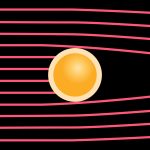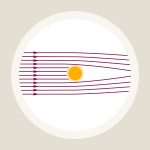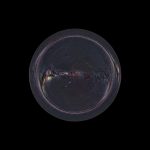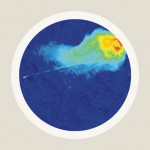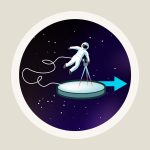A brief history of gravitational lensing
Historical sketch of the derivation of general relativity’s prediction of gravitational lenses and subsequent astronomical observations
An article by Tilman Sauer
Einstein’s derivation of the deflection of light in the Sun’s gravitational field, and the agreement between the quantitative prediction for that deflection based on his theory of general relativity and the observations made by an expedition under the leadership of Arthur Stanley Eddington (1882-1944), constitute one of the best-known episodes in the history of general relativity.
However, there is a lesser-known, but closely related fact. As early as 1912, a good three years before his final breakthrough in the formulation of general relativity, Einstein wrote down a concise description of one of the most important consequences of the deflection of light: The possibility of a (geometric) gravitational lens.
Einstein’s notebook and early publications
Such a lens consists of a mass M which deflects light from a distant light source S in such a way that the light reaches an observer O along two different paths. As a consequence, O will see two distinct images of S:

Einstein jotted down the basic properties of such a gravitational lens in one of his notebooks, presumably on the occasion of a visit to Berlin in April 1912. At that time, he had met up with the astronomer Erwin Freundlich (1885-1964), with whom he discussed different possibilities of testing his ideas using astronomical observations. The notebook contains rough sketches as well as the basic formulae needed to describe the lens effect. One of the pages is reproduced in the following image:
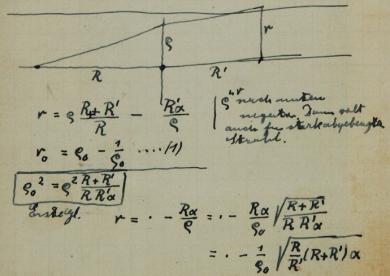
[Published as part of the Collected Papers of Albert Einstein, Vol. 3, p. 585; Reprinted by permission of Princeton University Press]
In the following years, the idea of a gravitational lens made its appearance in a number of different publications. Einstein himself mentions the phenomenon in a letter written on December 15, 1915 to his friend Heinrich Zangger (1874-1957), a professor of forensic medicine at the University of Zurich. It is also the subject of a brief article written by the physicist Oliver Lodge (1851-1940) and published in the journal Nature. Furthermore, gravitational lensing is discussed by Eddington in his book “Space, Time, and Gravitation”, which was published in 1920, and also in an article in the prestigious journal Astronomische Nachrichten, authored by the Russian physicist Orest Chwolson (1852-1934). However, all authors agreed that the phenomenon would not be observable – that there was no chance for terrestrial astronomers to find a gravitational lens in the sky.
A Czech visitor
In 1936, when Einstein was living in Princeton – having emigrated to the US three years earlier – he received a visit from a Czech emigré and amateur engineer by the name of Rudi W. Mandl. Mandl had come up with some far-reaching ideas, and he was eager to discuss them with his famous host. Among other things Mandl, too, had come up with the idea of a star acting as a gravitational lens, but he had gone even further and speculated that high-intensity starlight, focused by such a lens, might have influenced biological evolution here on Earth, by increasing the rate of genetic mutations.
Einstein received Mandl quite graciously. It seems that he had forgotten his own, earlier work on gravitational lenses, and evidently he was not familiar with what others had published since. In his discussions with Mandl, he conceded that the idea of a gravitational lens had merit, but persuaded Mandl to abandon his more outlandish musings.
Asked by Mandl to publish on the subject of gravitational lensing, Einstein at first declined, citing the fact that the phenomenon was unobservable. But Mandl persevered, and eventually, Einstein agreed to a brief publication in the journal Science:
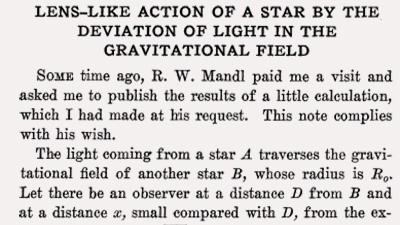
[From: Einstein, Science 84 (1936), p. 506; reprinted by permission of the AAAS]
Fall-out of the article in “Science”
Right after Einstein’s brief text had been published, it was followed by a number of articles by well-known scientists, who picked up where Einstein had left off.
Fritz Zwicky (1898-1974), an astronomer at the California Institute of Technology, discussed the possibility of observing the lensing effect in the case of the recently discovered extragalactic nebula, in other words: other galaxies. The typical masses, sizes and mutual distances of galaxies are such that double images of a distant galaxy should be significantly more frequent than double images of stars: The necessary near-alignment of a closer object, a more distant object and an observer here on Earth is much more probable for galaxies than for stars.
Henry Norris Russell, the astronomer from Princeton, published an article in which he speculated about the inhabitants of a hypothetical planet orbiting the White Dwarf companion of the star Sirius. What would they see during a total eclipse – on the occasion when, from the point of view of these inhabitants, the White Dwarf star would move in front of the more distant Sirius? As White Dwarfs are very compact objects, light from Sirius passing close to the companion would be markedly deflected. Of course, astronomers on Earth would not be able to see this relativistic gala performance, and in fact Russell cites this scenario as a perfect test of relativity theory which, regrettably, is impossible to put into practice.
Indisputably, Einstein’s little publication had lent credibility to the idea of gravitational lensing, and the concept became part of the general knowledge of theoretical astronomers.
Quasars and the first observation
The discovery of quasars in the early 1960s led to renewed interest in the theory of gravitational lensing, with notable contributions by Yu. G. Klimow, S. Liebes Jr. and S. Refsdal. Quasars are extragalactic objects, and they are both very distant and extremely bright. These properties combined make a distant quasar as a light source paired with a less distant galaxy as the deflecting mass an ideal candidate for an observable gravitational lens.
By that time, the models of gravitational lensing under discussion were already significantly more complex than for the early calculations. In fact, the description of a gravitational lens is simple only in the approximation of geometric objects, with light rays emitted by point-like sources deflected in a gravitational field with perfect spherical symmetry. In contrast, in any realistic situation neither the light source nor the lens mass will exhibit perfect symmetry. For more general situations, there is a much greater variety of possible images. One example is a fourfold image evenly grouped around a central image (however, the central image is not usually visible) – the cosmic version of a four-leaf clover, called an “Einstein cross”. Other examples include multiple images, rings and similar shapes, or arc-like deformations. Einstein’s simple derivation is woefully inadequate when dealing with these images – they are described using significantly more complicated models based on general relativity. Such models produce candidate shapes for possible gravitational lens images, and it is then up to astronomers to identify their real-life counterparts in the night sky.
The first gravitational lens was found in 1979 by Dennis Walsh, Robert F. Carswell and Ray J. Weymann, who identified the double quasar Q0957+561 as a double image of one and the same distant quasar, produced by a gravitational lens. The following illustration is a false color image of the object in question, based on radio observations:
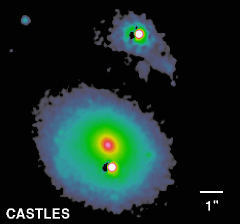
[Bild: CASTLeS]
Gravitational lensing
This first identification of a gravitational lens was soon followed by others. The image below shows a beautiful Einstein cross – a lensing system producing a four-leaf clover – formed by the quasar QSO 2237+0305. It was discovered in 1985:
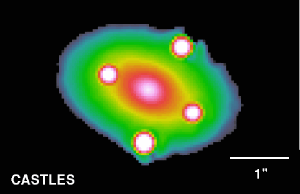
[Bild: CASTLeS]
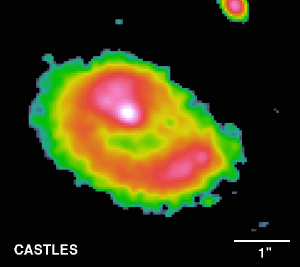
[Bild: CASTLeS]
In the twenty-first century, gravitational lensing is a highly active field of astrophysical research. Since the first conference exclusively devoted to gravitational lensing was held in Liège, France, in 1983, there have been similar international conferences every year.
The reason for the field’s growth is that, today, gravitational lenses are much more than just an interesting general relativistic phenomenon. Now that a significant number of lens systems has been identified, lensing is used more and more as an observation tool, allowing astronomers to answer astrophysical as well as cosmological questions, from estimates of the amount of dark matter contained in the lens mass to the determination of fundamental parameters of the big bang models.
Further Information
Introductory information about Einstein’s theory of gravity can be found in the section General relativity of Elementary Einstein.
Related spotlight texts on Einstein Online can be found in the category General relativity.
The Einstein notebook mentioned in the text has been published in M. J. Klein, A. J. Kox, J. Renn und R. Schulman (Hg.), “Collected papers of Albert Einstein” Vol. 3, Princeton University Press 1993, Appendix A. We would like to thank Princeton University Press for their permission to use the above image. Also, we would like to thank the AAAS and Science Magazine for permission to reprint the first lines of Einstein’s 1936 article.
Einstein’s writings can be accessed online thanks to the website Einstein Archives Online. There, you will find both the 1912 entry in the notebook and the manuscript for the 1936 Science article.
The catalogue resulting from the CASTLe Survey is accessible online on the CASTLeS homepage
An earlier version of this text appeared in the collection “Albert Einstein – Chief Engineer of the Universe: One hundred authors for Einstein” (Jürgen Renn, Ed.; Wiley-VCH: Berlin 2005), one of the companion publications to the exhibition Albert Einstein – Chief Engineer of the Universe.
Colophon
is a physics professor at Lesley University, Cambridge (USA). He is Senior Scientific Editor of the Collected Papers of Albert Einstein, the Einstein Papers Project at the California Institute of Technology.
Citation
Cite this article as:
Tilman Sauer, “A brief history of gravitational lensing” in: Einstein Online Band 04 (2010), 03-1005



